Trees with shallow roots do not have the ability to grow deep roots like other species, making them great options for landscaping in a variety of locations.
Read on below and explore the top 12 shallow root trees to consider for your landscape!
1. Willows
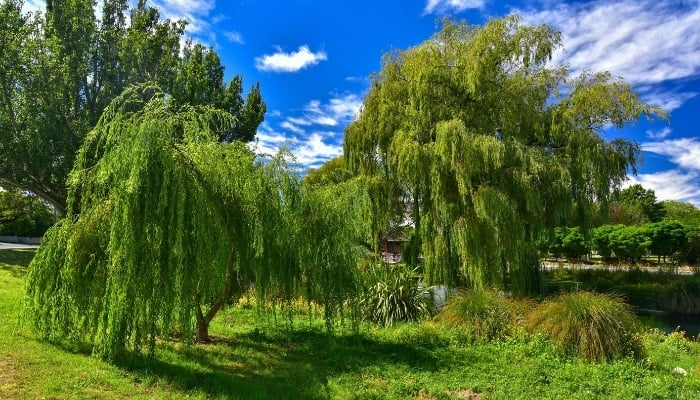
Willows are famous for their shallow and interlacing roots. Plant several of them together along streams, ponds, or anywhere else you want to avoid soil erosion.
The best species for landscaping is the gorgeous Salix babylonica, better known as the weeping willow tree.
The only downside is that you should avoid planting willows closer than 50 feet from the foundations of buildings on your property, including your home, due to their wide-spreading albeit shallow roots.
- Average height: 20 to 40 feet
- Average width: 45 to 65 feet
- Growth rate: 2 feet per year
- Root depth: 5 to 15 feet
- Root spread: 45 to 75 feet
2. Beech
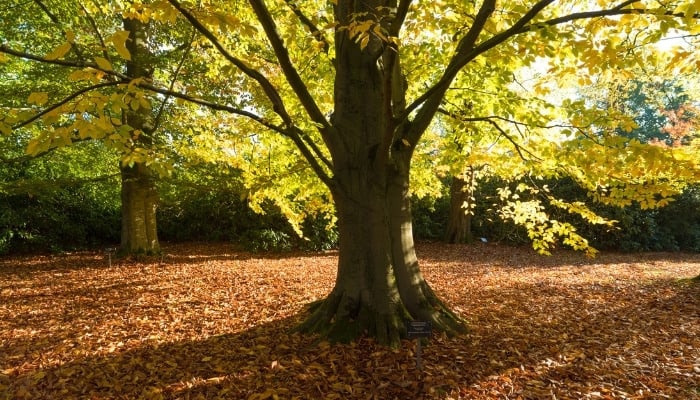
Beech trees are amazing trees that come in a variety of shapes and colors. They reach 50 feet high or taller and 30 to 40 feet wide at full maturity.
These trees grow around 24 inches per year and have relatively shallow roots for such potentially tall trees.
If your yard has well-draining soil, even on the slightly acidic side, Beech trees are one of the best shallow root trees to consider planting for the long term.
- Average height: 50 to 70 feet
- Average width: 30 to 40 feet
- Growth rate: 1 to 2 feet
- Root depth: 3 to 10 feet
- Root spread: 30 to 50 feet
3. Pin Oak
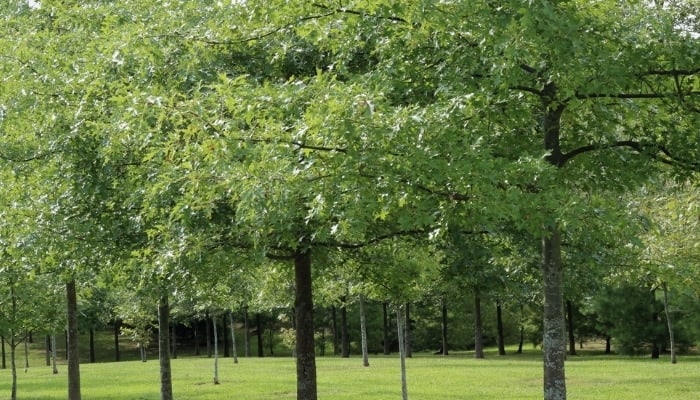
Pin oak is a popular shallow root tree species for landscaping thanks to their aesthetically pleasing look and the shade they eventually provide.
The trees have a standard growth rate of approximately 24 inches per year and have roots that only penetrate the ground a couple of feet or so on average.
They reach heights of 80 feet or more, with up to 40-foot wide canopies, making them excellent for the front, side, or back yard.
- Average height: 60 to 80 feet
- Average width: 25 to 40 feet
- Growth rate: 2 feet
- Root depth: 10 to 26 inches
- Root spread: 25 to 50 feet
4. Norway Maple
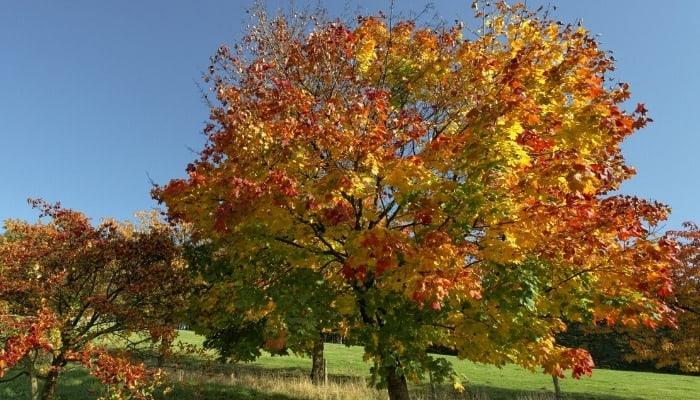
The Norway maple is another excellent shallow root tree that’s amazing for shade. The good thing is that it doesn’t grow as tall as some shade trees (and grows slightly wider than some).
The growth rate of the Norway maple isn’t exactly fast, but it’s far from slow at slightly more than 12 inches per year. Some trees grow half of that in a year or less.
You can expect a root spread of up to two dozen feet or less with these trees as well as root penetration of only about 2 feet deep.
- Average height: 40 to 60 feet
- Average width: 30 to 50 feet
- Growth rate: 1 to 1.5 feet
- Root depth: 1 to 1.5 feet
- Root spread: 20 to 25 feet
5. Sugar Maple
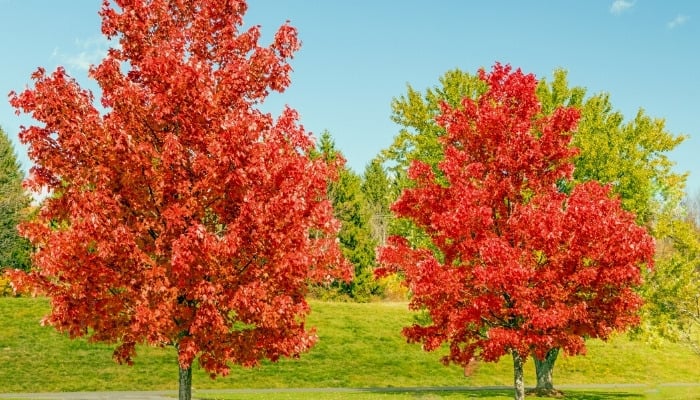
For fall colors, there are few shallow root trees that are as landscape friendly as the sugar maple. In the fall, their vivid red, orange, and yellow colors stand out among the other trees in the neighborhood.
The tree grows around 1.5 feet per year and rarely penetrates the ground more than a few feet deep with its root system. They are among the faster-growing maples out there.
Sugar maples may reach heights of more than 75 feet, though most top out around 60 or so with a width of around 40 feet on average.
- Average height: 60 to 75 feet
- Average width: 40 to 50 feet
- Growth rate: 1 to 2 feet
- Root depth: 1 to 1.5 feet
- Root spread: 20 to 25 feet
6. Silver Maple

The speed at which silver maple grows makes it the fastest growing of all maples. That’s why it’s one of the most popular for landscaping. Its shallow roots make it an even better choice.
This fast-grower shoots up over 24 inches per year while maintaining shallow roots of around 24 to 36 inches. That’s fast growth for a tree in general.
Most silver maples top out between 50 to 60 feet tall, though some reach well over 80 feet. Root spread is around half the width of the mature canopy.
- Average height: 50 to 80 feet
- Average width: 35 to 50 feet
- Growth rate: 2 feet
- Root depth: 1 to 2 feet
- Root spread: 20 to 30 feet
7. Crabapple
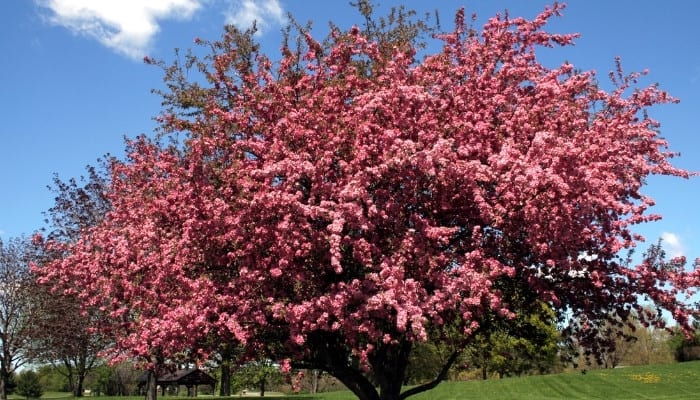
Crabapple trees are another great tree that has shallow roots and works well for landscaping projects.
The growth rate is a bit slower than others, at less than 12 inches per year on average, but it’s a much smaller tree as well.
The average crabapple tops out at around 20 to 25 feet, though they can be several feet shorter or taller. Their roots spread about 20 feet wide under the ground.
- Average height: 20 to 40 feet
- Average width: 15 to 20 feet
- Growth rate: 7.5 to 12 inches
- Root depth: 8 to 20 feet
- Root spread: 15 to 25 feet
8. Birch

Birch is an amazing tree with white bark and interestingly shaped trunks and branches. It offers much more to look at in general than other landscaping trees.
They are one of the most popular shallow root trees for landscaping; however, they are also one of the most short-lived and pest/disease prone on our list.
At any rate, their roots only spread around 20 feet at maturity and are only 3 or 4 feet deep. The trees top out height-wise at 50 feet or slightly taller and around the same size in width.
- Average height: 40 to 70 feet
- Average width: 35 to 60 feet
- Growth rate: 1 to 2 feet
- Root depth: 18 to 36 inches
- Root spread: 15 to 35 feet
9. Blue Spruce

Blue spruce grow 50 feet tall or higher and up to 20 feet wide, making them a great choice for property boundary markers and privacy borders.
Plant them along your property’s edge, but make sure to give them 10 to 20 feet of space to grow.
Amazingly, their roots only spread around 5 to 10 feet or so away from their bases and up to a few feet deep into the ground.
- Average height: 45 to 70 feet
- Average width: 10 to 20 feet
- Growth rate: 1 to 2 feet
- Root depth: 12 to 24 inches
- Root spread: 3 to 12 feet
10. Serviceberry
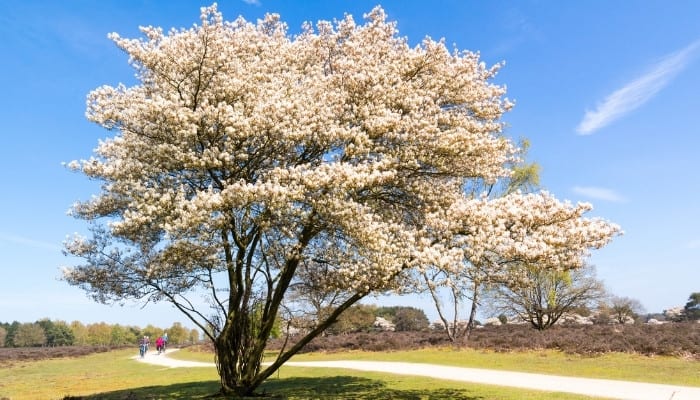
The serviceberry tree is actually a group of around 20 species, each appearing just slightly different. The average serviceberry reaches heights of around 15 feet with a canopy of about 10 feet wide.
The roots of these small trees penetrate the ground sometimes less than an entire foot but may shoot down over a few feet over time.
For landscaping, they fit just about anywhere you want to add a bit of color as they have bright-white blossoms and attractive red berries for part of the year.
- Average height: 10 to 30 feet
- Average width: 10 to 15 feet
- Growth rate: 1 to 2 feet
- Root depth: 8 to 32 inches
- Root spread: 5 to 10 feet
11. Cottonwood
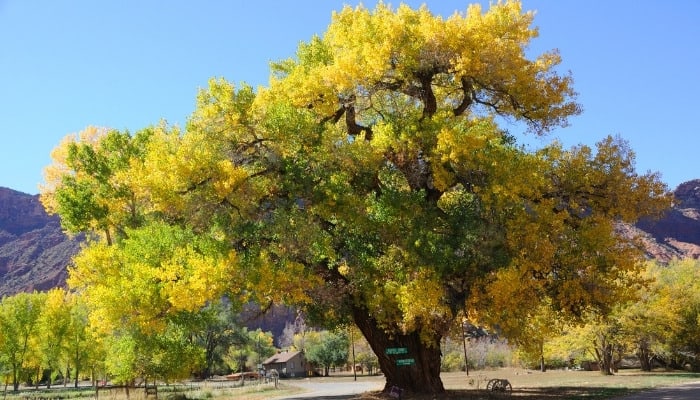
Cottonwoods are more often used for their lumber to build planks, furniture, pallets, and other wooden products than they are planted for landscaping.
That said, they make great trees for shade and to fight soil erosion along the sides of fields.
These tall giants reach heights of well over 100 feet, sometimes nearly 200 feet. They spread out about 50 to 60 feet on average with roots systems about the same size.
The average depth of cottonwood roots is just under 6 feet deep, making them perhaps the tallest of all shallow-rooted trees for landscaping.
- Average height: 90 to 180 feet
- Average width: 50 to 75 feet
- Growth rate: 6 to 12 feet
- Root depth: 10 to 48 inches
- Root spread: 35 to 70 feet
12. Fruit Trees

Fruit trees are far from all the same, but they are often maintained and manicured for easier fruit production and harvesting.
The average fruit tree grows to heights of over 15 to 20 feet but is mainly maintained at 10 to 15 feet tall.
Likewise, the average fruit tree may achieve natural widths of well over 20 feet but is typically maintained at a width of 15 feet or so.
The good thing is that they only penetrate the ground between 2 or 3 feet and up to around 5 to 10 feet on the high end. The roots may spread up to 15 feet or so.
- Average height: 10 to 15 feet
- Average width: 15 to 20 feet
- Growth rate: 1 foot
- Root depth: 3 to 5 feet
- Root spread: 10 to 20 feet
Conclusion
So, there you have it; 12 great landscaping trees with shallow roots for you to consider adding to your landscape.
Whether you’re looking to increase the shade around the house, tweak the flower beds, or line the driveway with stately looking specimens, there’s a tree with shallow roots on our list for you.
Hopefully, we’ve made your decision an easier and better-informed one!

